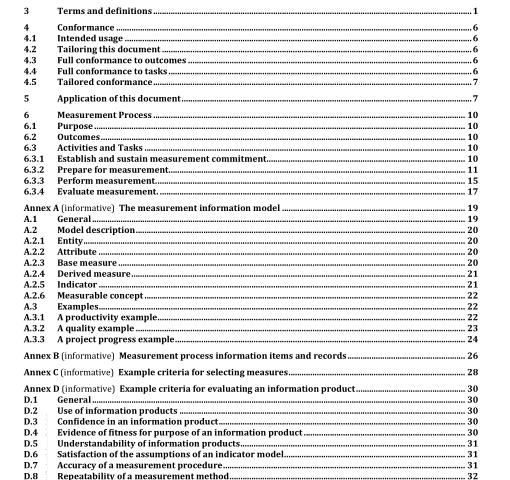IEEE 15939-2017 pdf download.Systems and software engineering — Measurement process
When this document is tailored per 4,2, the tailored text, for which tailored conformance is claimed, is declared, Tailored conformance is achieved by demonstrating that the outcomes, activities, and tasks, as tailored, have been achieved.
S Application of this document
This clause presents an overview of the measurement process. The objective is to orient the users of this document so that they can apply It properly within context
This document defines the activities and tasks necessary to implement a measurement process. An activity Is a set of related tasks that contributes towards achieving the purpose and outcomes of the measurement process (see 6.1 and 6.2). A task is a well’defined segment of work. Each activity is comprised of one or more tasks. This document does not specl4’ the details elbow to perform the tasks Included In the activities.
The properties of the activities of the measurement process that are defined in this document are the same properties defined in ISOIIEC/IEEE 15288 and I5O/IEC/IEEE 12207. This means that other properties such as entry and exit criteria for each of the activities are not defined In this document.
NOTE I This measurement process supports the measurement requirement defined in ISO 9001:2015,11.2.
NOTE 2 This document prnvidm an elaboration of the measurement process from ISO/JEC/IREE 152H8 and ISO/IEC/IEEE 12207. More detail Is provided via additional activities and tasks. As part of this elaboration, one additional outcome (commitment as established and sustained) is added, with associated activities and tasks. Thin outcome is addressed in lSOflF.C/IEEE I S2ItR and ISO/lF.C/IEEE 12207 at the orgasisation level.
The measurement process consists of four activities as illustrated in the process model in Figure 1. The activities are sequenced in an iterative cycle allowing br continuous feedback and improvement of the measurement process. The measurement process model in FIgure 1 Is an adaptation or the Plan’Do’Check’Act cycle commonly used as the basis for quality Insprovement. Within activities, the tasks are also iterativa
The ‘Technical and Management Processes’ or an organizational unit or project are not within the scope of this document although they are an important external interface to the measurement activities that are induded in this document
Two activities are considered to be the Core Measurement Process: Prepare the Measurement Process, and Perform the Measurement Process. These acttvities are included in the Measurement process in lSO/IECJIEEE 152KB and l5O/IEC/IEEE 12207 and mainly address the concerns of the measurement user The other two activIties, Establtsh and Sustain Measurement Consnilnsient and Evaluate Measurement, provide a Inundation for the Core Measurement Process and provide feedbadc to It These latter two activities address the concerns of the measurement process owner. They are included in the set of life cycle processes as activities in the Project Planning process and the Quality Assurance process, respectively. At the organization level, this is handled by the l.IIe Cycle Model Management process, which evaluates and improves the organization’s processes.
Figure 1 shows that the Core Measurement Process is driven by the information needs of the organization. For each inforsnation need. the Core Measurement Process produces an information product that satisfies the InformatIon need. The information product Is conveyed to the organization as a hasts for decision-making. The link between measures and an information need Is described as the Measurement information Model in Annez A. This annex also includes examples.
Performance of the normative activities and tasks defined in this document satisfies at k-cast the Capability Level 1 requirements in ISO/IPX 33020. However, the guidance Included in this document provides the basis for implementing the measurement process at progressively higher levels of capability.
The process defined in this document includes an evaluation activity, as shown in Figure 1. The intent is to emphasize that evaluation and feedback are an essential component of the measurement process, and should lead to improvements of the measurement process and measures. IEEE 15939 pdf download.IEEE 15939-2017 pdf download
IEEE 15939-2017 pdf download

Leave a Reply